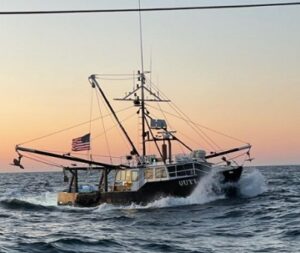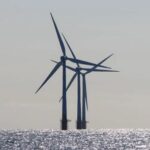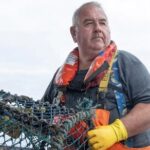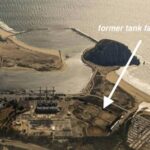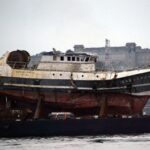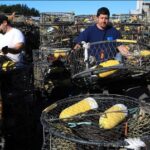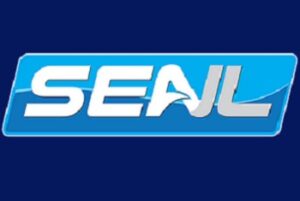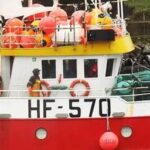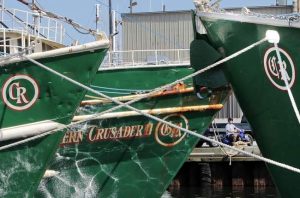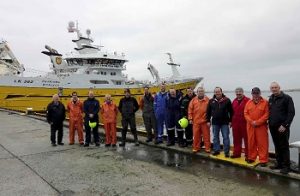Tag Archives: nefmc

The Cape’s Scallopers Ride Out a Perfect Storm
This summer, a perfect storm combining sky-high fuel costs, a scarcity of experienced crew members, low wholesale prices, sharp declines in what scallop fishermen are allowed to take, and costly quota, has been keeping Cape Cod’s small-boat scallopers off the water. “There are a quite a few changing over to do other kinds of fishing because they can’t afford to go scalloping right now,” said Max Nolan, a scalloper from Eastham who owns the F/V Outlaw. “I don’t know how anyone is making it,” said Chris Merl, a Wellfleet scalloper and captain of the F/V Isabel & Lilee. Atlantic scalloping, which stretches from the waters of Maine to North Carolina, is one of the most lucrative fisheries in the nation, with its yearly catch valued at upwards of $500 million. But this year (the fishing year begins in April and ends in March), regulators have dropped the total amount of scallops boats are allowed to harvest to its lowest level in over a decade, and the limit stands at just 41 percent of what it was in 2019. >click to read< 08:55
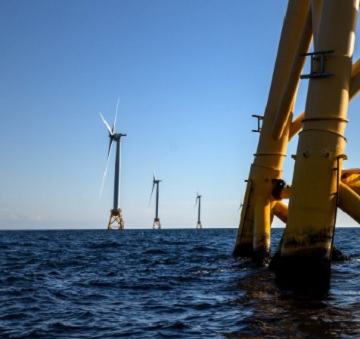
EXCLUSIVE: Federal Regulator Acknowledges Danger to Wildlife Caused by Offshore Wind Farms
Captain Jerry Leeman, who heads the fishing vessel F/V Teresa Marie IV, sent a copy of the Norwegian haddock study to Nies in a January 9 letter. “Thank you for your January 9 letter … A federal fisheries council acknowledged that some power cables for offshore wind turbines could harm certain fish, according to a letter seen by the DCNF. Multiple recent studies have demonstrated that a variety of commercially popular fish can be negatively impacted by their exposure to magnetic fields emitted by high voltage direct current cables, which can confuse their ability to navigate and, in some cases, leave them exposed to predators. “We were previously aware of this study and agree that it has concerning implications for the possible effects of high voltage direct current cabling on larval behavior and resulting predation rates,” Thomas Nies, executive director of the New England Fishery Management Council (NEFMC), said in a January 18 letter. >click to read< 20:01

Atlantic sea scallops at lowest biomass in over 20 years and what that means for New Bedford
A Scallop Survey Report presented at the NEFMC meeting Tuesday showed the Atlantic Sea scallop fishery is facing its lowest biomass in over 20 years. Throughout the NEFMC jurisdiction, the survey estimated a biomass decrease of almost 30%. The Georges Bank region saw the largest drop, around 36%. Tyler Miranda, a scalloper Captain and owner who came to prominence during the recent scallop license allocation debate, said that though it is of concern, the announcement does not worry him too much. “Obviously I worry, but what I’ve come to realize about the scallop industry is it fluctuates year to year,” Justin Mello said he felt similarly. “I’m only gonna go into the areas they allow us to, that’s why they call it fishing and not catching.” >click to read< 14:20
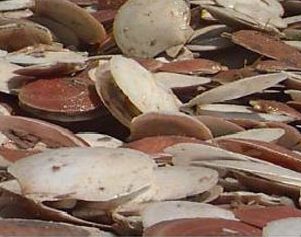
NEFMC to hold first scallop leasing meeting in Gloucester
Scallopers, Gloucester will be the scene of the first of seven in-person meetings and two webinars over the next two months as the New England Fishery Management Council conducts scoping for a limited access Atlantic Sea scallop program. The meeting will take place Wednesday, April 27, from 5 to 6:30 p.m. at Cruiseport Gloucester, 6 Rowe Square. The Newburyport-based council “is charged with conserving and managing fishery resources from 3 to 200 miles off the coasts of Maine, New Hampshire, Massachusetts, Rhode Island and Connecticut,” with major ports Gloucester, New Bedford, and including Portland, Maine, according to its website. >click to read< 10:48
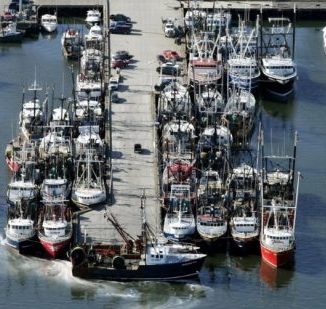
Mayor wants New Bedford voice on NEFMC
The last New Bedford voice on the council was John Quinn who left in 2021 and was replaced by Michael Pierdinock of Plymouth. Eric Hansen is looking to be the New Bedford voice on the council. “We’re the largest valued fishing port in the nation and to not have a voice on the council is just wrong,” Hansen said. Hansen has been a scallop fisherman, like his father and grandfather before him, for 44 years. He doesn’t go to sea anymore but his scallop vessel F/V Endeavor does and these days his son is at the wheel, serving as captain. >click to read< 09:12
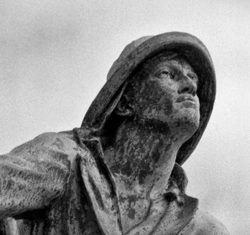
I am not happy. Jackie Odell was not appointed to serve on the NEFMC.
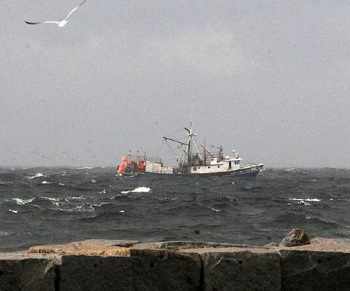
NEFMC votes to set a future target of 100% monitoring coverage on sector based groundfish vessels
The council, deliberating online via webinar on Amendment 23, overwhelmingly approved the motion for its preferred alternative of 100% coverage level for sector vessels in the Northeast Multispecies groundfish fishery. But the motion, crafted through a morning and afternoon of rulemaking on the fly, included a valuable caveat for fishermen: The region’s commercial groundfish harvesters likely won’t have to pay the full costs for the monitoring for the first four years the amendment is in effect or as long as supporting federal funds last. According to the approved measure, the commercial fishing industry will receive federal reimbursements, or money from other federal mechanisms, for 100% of their electronic monitoring costs and 100% of their at-sea monitoring costs in the first four fishing years the amendment is in effect. >click to read< 07:41

NE Groundfish Fishery in Hail Mary mode – Monitor vote could be death knell for fleet
A quick recap: The council has been working on Amendment 23 for more than two years. It seems like 50. The amendment will set future monitoring levels for sector-based groundfish vessels. The council faces four alternatives: Monitors aboard 25%, 50%, 75% or 100% of groundfish trips. The council has chosen 100% coverage as its preferred alternative. That’s not good for the groundfishermen. Once the federal government stops harvesting spare change from between the sofa cushions to keep reimbursing the fleet for at-sea monitoring, the onus for paying falls on the fishermen at a current tune of about $700 per day per vessel. >click to read< Online access to the meeting is available by >clicking this link< 10:24

NEFMC will vote Sept. 30 on changing requirements for groundfish monitoring, fishermen have mixed responses
Commercial fisherman Randy Cushman walks on top of his boat where he measures fish in front of electronic monitoring cameras, pictured to the right. Cushman is among a handful of New England fishermen who use electronic monitoring instead of a traditional human observer to track what they catch and discard. The New England Fisheries Management Council (NEFMC) is scheduled to vote on changes to its groundfish management plan at a virtual meeting Sept. 30, culminating four years of research. “If we’re going to have accurate stock assessments, we need 100 percent coverage under this management system,” said Cushman. But, the prospect of increased monitoring concerns Terry Alexander, a fisherman who represents Maine on the NEFMC and operates his 62-foot boat out of Massachusetts. >click to read< 10:57

Fishermen, state leaders push back against at-sea monitoring proposal
The New England Fisheries Management Council (NEFMC) is considering Amendment 23 to the Northeast Multispecies Fishery Management Plan (FMP) that would require groundfishing vessels to implement 100% at-sea monitoring or a blended approach of at-sea monitoring and electronic monitoring. The proposed change seeks to improve catch accountability in the fishery, but fishermen argue this particular proposal is overly burdensome and unnecessary to achieve the stated goal,,, Overall, fishermen across Massachusetts fear this proposed policy would incur overly burdensome costs on an already struggling fleet, accelerating the expiration date of the fishery.” >click to read< 11:52

Family Fishermen Move to Block Industry-Killing At-Sea Monitoring Rule
Cause of Action Institute (CoA Institute) today filed a motion for summary judgement on behalf of a group of New Jersey fishermen, asking a D.C. Federal Court to vacate job-killing fisheries regulations called the “Omnibus Amendment.” CoA Institute filed suit in February to challenge the industry-killing rule, which requires certain boats in the Atlantic herring fishery to carry “at-sea monitors” at their own cost. The Omnibus Amendment—designed by the New England Fishery Management Council (NEFMC) and finalized by the National Oceanic and Atmospheric Administration and the Department of Commerce—is expected to cost fishermen upwards of $700 a day, leading to a projected 20% drop in returns-to-owner (profit). Not only is this industry already overregulated, but the agencies are forcing this unlawful rule upon fisherman without any statutory authority to do so. >click to read< 15:25

New England Fishery Management Council meeting in Portsmouth, N.H. January 28-30. 2020
The New England Fishery Management Council will be meeting at the Portsmouth Event Center, 100 Deer Street at 22 Portwalk Place, Portsmouth, N.H. To read the final agenda, >click here< Register for webinar >click here< to listen live. 12:48
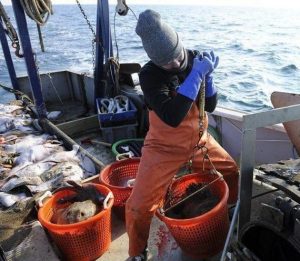
Northeast Seafood Coalition questioning the NEFMC fish monitoring regulation process
The New England Fishery Management Council is set to resume action on the contentious groundfish monitoring amendment next week, but the Gloucester-based Northeast Seafood Coalition is questioning whether the council is rushing its own process and operating with incomplete information. The council, scheduled to meet for three days next week in Portsmouth, New Hampshire, will return Wednesday to the arduous task of completing Amendment 23, which will set monitoring levels for vessels operating within the Northeast multispecies groundfish fishery. >click to read< 13:36

Scallop season is underway
The scallop fishing season got underway in eastern Maine earlier this month and is already making news. In the waters between eastern Penobscot Bay and Cobscook Bay, the season for the handful of licensed scallop divers began Nov. 18 but the draggers couldn’t go to work until Dec. 2. In Cobscook Bay, the season for draggers also began Dec. 2 but divers had to wait until Dec. 5 to brave the chilly, turbulent waters way Downeast. >click to read< 20:14
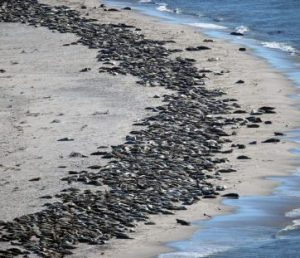
CLF says nothing short of an end to directed fishing – Another cut in cod fishing not enough for environmentalists
Fishing regulators are proposing another cutback to the catch limits for Atlantic cod, but some environmentalists say the move isn’t significant enough to slow the loss of the species. Atlantic cod fishing was once one of the biggest marine industries in New England, but the fishery has deteriorated after years of overfishing and environmental changes. Fishermen caught less than 2 million pounds of the fish in 2017, decades after routinely catching more than 100 million pounds annually in the early 1980s. It was the worst year for the fishery in its history. >click to read< 10:31
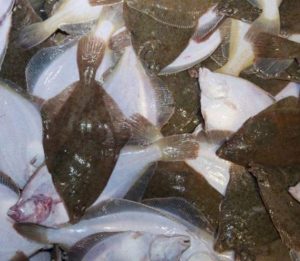
Coast Guard Report: Catch misreported on 350 fishing trips by Northeast multispecies groundfishery vessels
In its 21-page report, the Coast Guard said the analysis by its Boston-based First District enforcement staff identified more than 350 vessel trips during the period of 2011 to 2015 in the Northeast multispecies groundfishery “where there appears to be evidence of misreporting.” The analysis placed a particular focus on potential misreporting by vessels fishing in seasonal fisheries or fishing the same stock in more than one stock area. The goal of the misreporting, according to the report, is to keep fishing without exceeding catch limits and annual catch entitlements. >click to read< 07:10

New England Joins Mid-Atlantic to Require eVTRs for Vessels with Federal Commercial Permits for Council-Managed Species
The New England Fishery Management Council is taking steps to bring all commercial fishermen who hold federal permits for Council-managed species into the digital age by requiring vessel trip reports (VTRs) to be submitted electronically instead of on paper. These electronic reports are known as eVTRs, and this proposed action will apply to all of the Council’s fishery management plans. The Mid-Atlantic Fishery Management Council (MAFMC) has been working since December of 2018 on a Commercial eVTR Omnibus Framework Actionthat would apply to all vessels with federal commercial permits for MAFMC-managed species, which include,,, >click to read< 17:41

Herring cuts another headache for lobstermen
Maine lobstermen are catching it coming and going, but the “it” ain’t lobsters. Last month, the lobster industry found itself confronted with a demand from federal fisheries regulators that it reduce the risk it posed to endangered right whales by 60 percent and began the arduous task of figuring out how to remove half the vertical buoy lines attached to lobster traps from the water. Though it came as no surprise, earlier this month the New England Fishery Management Council announced that the already scant amount of herring allowed to be caught off the coast of New England would be further reduced in 2020 and 2021. >click to read<11:34
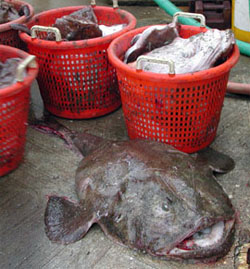
NEFMC Initiates Monkfish-Skate Specifications; Approve Monkfish RSA Priorities; Discuss Skate Limited Access
The New England Fishery Management Council covered several issues related to monkfish and skates during its mid-June meeting in So. Portland, Maine. The Monkfish and Skate Plan Development Teams (PDTs) will work on specifications and related measures over the summer and report back to their respective committees and advisory panels.,,, Monkfish Research Set-Aside Program The Council approved the following research priorities for the upcoming 2020-2021 RSA request for proposals. These are ranked in order of preference. Monkfish RSA Priorities for 2020-2021 >click to read<16:45
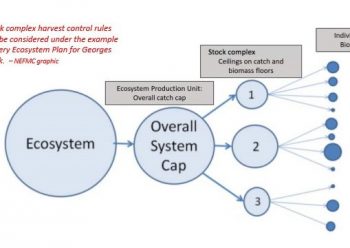
N.E. Fishery Management Council Hosts Offshore Wind Session; Discusses EBFM, Commercial eVTRs, and Research Set-Aside Program Review
Council Hosts Offshore Wind Special Session; The Council reaffirmed its commitment to stay engaged in tracking ongoing offshore wind developments and will continue to provide comments during appropriate opportunities along the way. All presentations and documents are available – Ecosystem-Based Fishery Management (EBFM), Commercial Electronic Vessel Trip Reporting (eVTR), ResearchSet-Aside (RSA) Program Review, lots of links! >Click to read the various details of these issues.<13:18
NEFMC Public Hearing Sessions for Limiting Entry to Federal For-Hire Groundfish Fishery
The New England Fishery Management Council (NEFMC) has scheduled a series of public listening sessions throughout New England. The purpose of the sessions is to have preliminary public discussions on the possibility of developing an amendment to the Northeast Multispecies Groundfish FMP to establish a limited access program for the party and charter boat fishery. >click to read dates, time, and place< 15:55
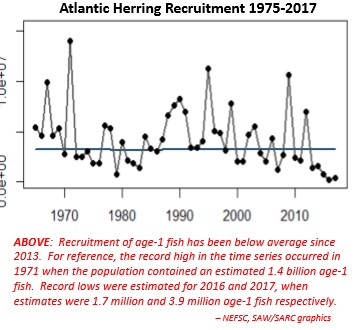
NEFMC Approves Atlantic Herring Amendment 8; Asks NMFS to Set 2019 Catch Limits
On September 25 during its meeting in Plymouth, MA, the New England Fishery Management Council approved Amendment 8 to the Atlantic Herring Fishery Management Plan. The Council also asked the National Marine Fisheries Service (NMFS, NOAA Fisheries) to develop an in-season action to set 2019 specifications for the herring fishery. ABC Control Rule: The acceptable biological catch (ABC) control rule is a formula that will be used to set annual catch limits. The Council considered close to a dozen alternatives that would allow different levels of fishing mortality depending on the estimated level of herring biomass in the ecosystem.,, Potential Localized Depletion and User Conflicts –Buffer Zone, Stock Status and 2019 Catch Limits,,, >click to read<21:34

2018-2019 Monkfish Research Set-Aside (RSA) Program
Three new cooperative research projects announced today will improve understanding of monkfish biology and how to reduce catch of skates in monkfish gillnet gear. The projects are possible because of an innovative program established by the New England and Mid-Atlantic Fishery Management Councils, and managed by NOAA Fisheries in the region. Under it, monkfish fishing days are set-aside each year and revenue generated from the sale of those days are used to pay for research projects. Award recipients for the 2018-2019 Monkfish Research Set-Aside (RSA) Program include the Coonamessett Farm Foundation, Cornell Cooperative Extension of Suffolk County, and the University of New England. >click to read<10:08
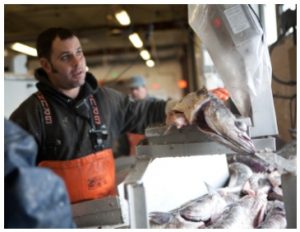
NEFMC Discusses Offshore Wind, Clam Dredge FW, Skates, Groundfish, Herring, IFM, and More at Mid-April Meeting
The New England Fishery Management Council met April 17-19 in Mystic, CT and discussed a wide range of issues that touched on everything from industry-funded monitoring to offshore wind, Clam Dredge Framework, Skate Wing Fishery, Northeast Multispecies -Groundfish, Atlantic Herring –River Herring/Shad, The New England Council paid tribute to two retiring Council members –Mark Alexander of Connecticut, left, who served on the Council for 10 years, and Mark Gibson of Rhode Island, >click to read<15:16
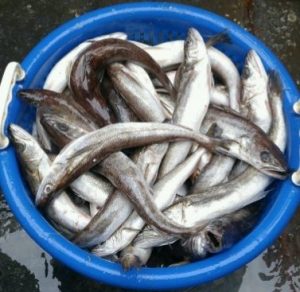
NEFMC: Scallops, Council Approves Framework 29 – Whiting, Approves 2018-2020 Specifics; to Send Amendment 22 to Public Hearing
The Council took two actions today related to small-mesh multispecies, which include two stocks of silver hake and offshore hake –collectively known as “whiting” –and two stocks of red hake. click here to read the notice 16:37
The Council today approved a sweeping package of measures for Framework Adjustment 29 to the Atlantic Sea Scallop Fishery Management Plan. The framework includes specifications for the 2018 scallop fishing year, which begins April 1, as well as default specifications for 2019. It also includes actions related to Closed Area 1 carryover pounds, the Northern Gulf of Maine Management Area, and flatfish accountability measures, among others. click here to read the notice







